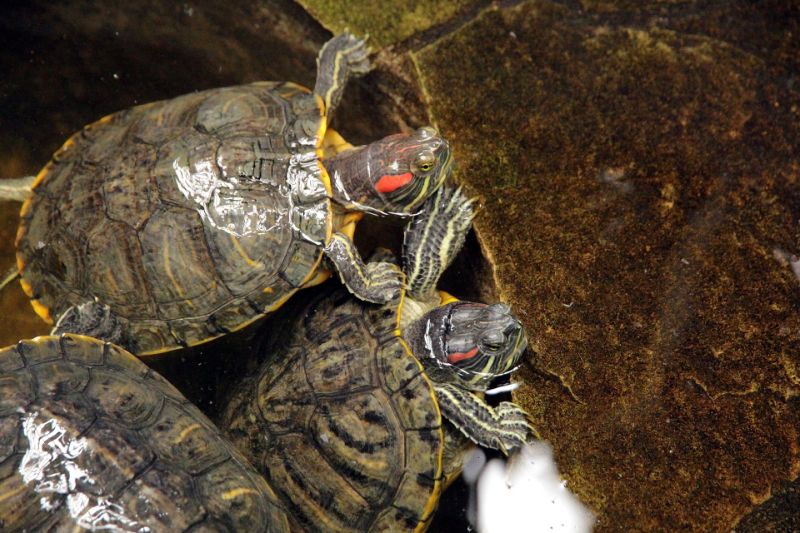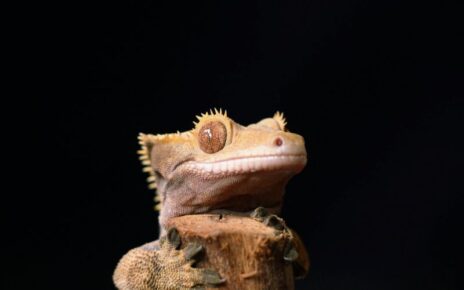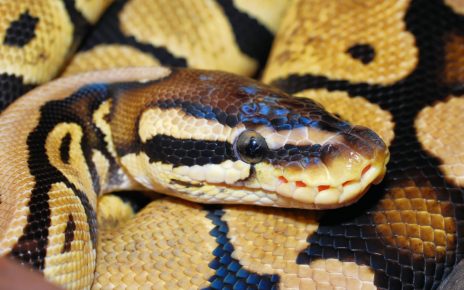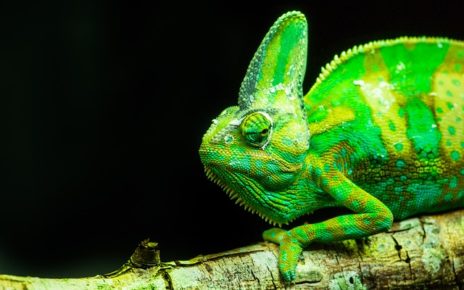There are many different types of water turtles, and each has its own unique attributes and temperament. Some are small and timid, while others are large and aggressive. It’s important to learn about the specific type of turtle you’re considering before bringing it home, as some turtles require more care than others.
On this page, we’ll discuss some of the most common types of aquatic turtles and their distinguishing characteristics. So whether you’re a seasoned turtle owner or just thinking about getting one, read on for some helpful information.
Types of Water Turtles – Types of Aquatic Turtles
Red-Eared Slider (Trachemys scripta elegans)
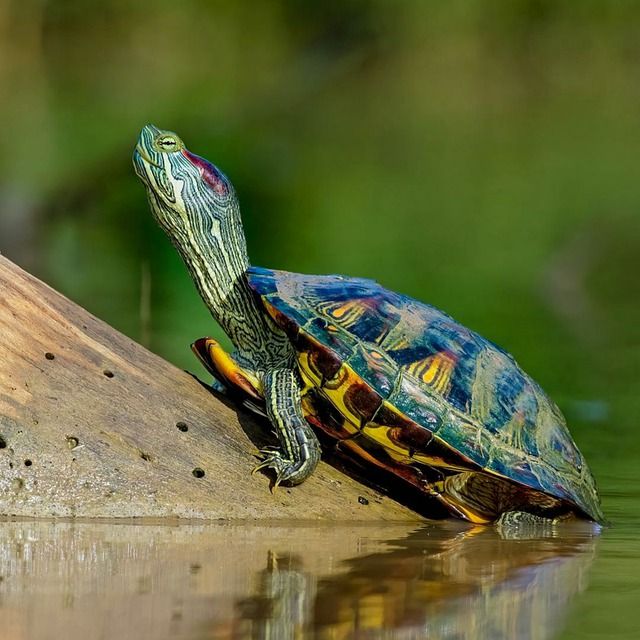
Red-Eared sliders are a popular pet due to their hardy nature. They are green with yellow stripes on their shells, and they get their name “red-ear” because of the two small red spots on the side of their head.
Red-Eared sliders can grow to be 12 inches (30.5cm) long and they can live for up to 70 years.
They are omnivores and typically eat bugs, worms, tadpoles, fish eggs, and some plants.
As pets, they make great additions to any family or classroom, but like anything else in life, there are things you should know about before taking one home.
At a minimum, a 20 to 50 gallon (76 to 189 liter) tank is recommended for one slider, and they prefer to be kept at a temperature of 75-80F (24-27C), and a water temperature of 75-84F (24-29C). They also like to have a basking spot that reaches 90F (32C) in order to properly thermoregulate.
Related: Best Tank for a Red-Eared Slider
Reeves Turtle (Mauremys reevesii)
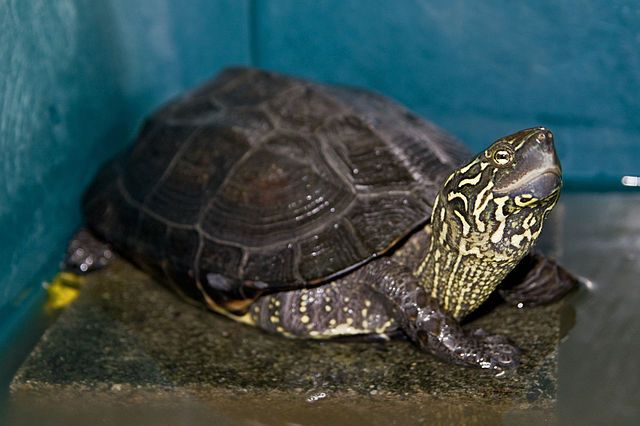
Reeves turtles are great beginner turtles for those looking to get into the hobby. They are easy to breed and have a gentle temperament, making them an ideal pet for children. They will reach a maximum size of 6-inches (15 cm) so they don’t require a lot of space, and their dark color shell makes them easy to spot if they happen to escape.
The Reeves Turtle is a good choice for people who want to keep an aquatic turtle in their home, but don’t have the space required by other species. Plus, they are small and peaceful so they can be kept with fish without being aggressive.
If you’re interested in keeping Reeves turtles as pets, do your research first, and make sure you have the proper turtle tank setup and know how to feed them properly.
They enjoy both meaty foods as well as plants, including lettuce leaves and watermelon slices. This makes them more flexible than some of the larger turtles when it comes to diet.
Their tank size should be at least 50 gallons (189 liters) with an air temperature of 75-85 degrees Fahrenheit (24-29 Celsius). And keep in mind that these turtles need to bask on warm surfaces, so providing a basking spot between 85-95 degrees Fahrenheit (29-35 Celsius) will help ensure they can warm up after they eat.
Mississippi Map Turtle (Graptemys pseudogeographica)
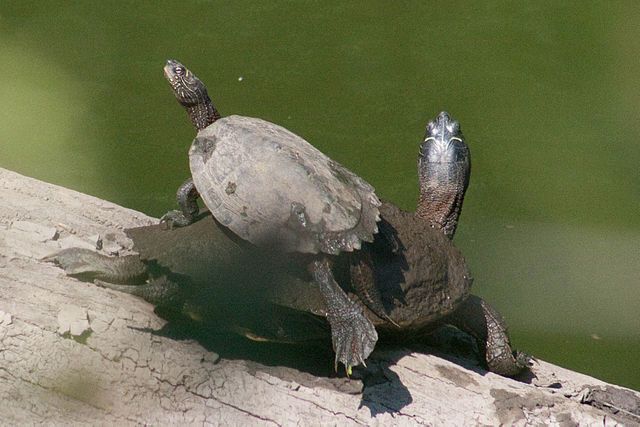
The Mississippi Map Turtle is a moderately difficult turtle to keep. They are generally peaceful but will defend themselves if threatened or handled roughly. Their diet consists of plants and small animals like worms, crickets, snails, shrimp, and fish.
These turtles get their name from the map-like markings on their shells, and males grow to be 10 inches long while females can grow to be over 20 inches.
A 50-gallon tank should be enough room for a young male map turtle, but an adult female will need to be kept in a pond or a 200+ gallon tank. They prefer to be kept at an air temperature between 80-85F (27-29C) and they need a basking spot that reaches 85-95F (29-35C) to keep them active and eager to eat.
Be aware that map turtles are very sensitive to water quality and require clear unpolluted water with no detectable ammonia and very low nitrates to remain healthy.
Related: Unionized Ammonia Calculator
Painted Turtle (Chrysemys picta)
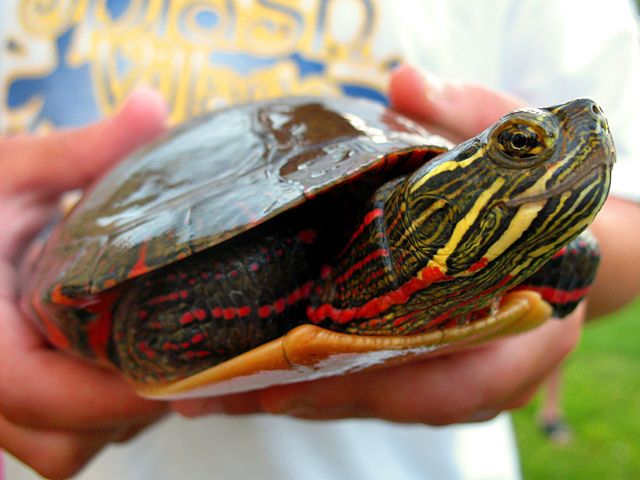
Painted turtles are a great pet for beginner reptile owners because they’re easy to care for and don’t require a lot of work.
These turtles are easily identified by their black shells accented with bright yellow and red markings. They typically reach a maximum length of 10-inches (25cm) and can live for 25 to 30 years.
They do need room to swim, but that’s not difficult given their turtle tank size requirements. A tank for a painted turtle should be at least 40 gallons with a temperature between 75-85F (24-29C).
However, painted turtles are very active and spend most of their time swimming around looking for food, so you might want to consider putting them in a pond or a Rubbermaid stock tank.
Razor-Backed Musk Turtle (Sternotherus carinatus)
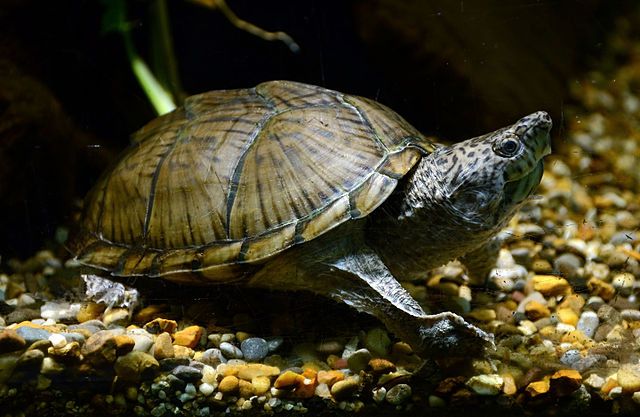
Razor-backed musk turtles get their name from the strong defensive odor they release when startled or threatened. These small turtles can reach a maximum adult length of 6-inches (15 cm) and are true aquatic turtles that stay submerged for most of the day.
The razor-backed musk turtle is a small, peaceful turtle that is perfect for beginner turtle enthusiasts. However, Razor-backed musk turtles are shy creatures that will bite if they feel cornered or threatened.
This carnivorous turtle loves to eat live prey such as earthworms, crickets, and fish. A 30-gallon tank is a perfect size for one or two of these turtles, and they like a slightly cooler air temperature of 75-80F (24-27C) and a water temperature of 73-78F (23-26C).
Wood Turtle (Glyptemys insculpta)
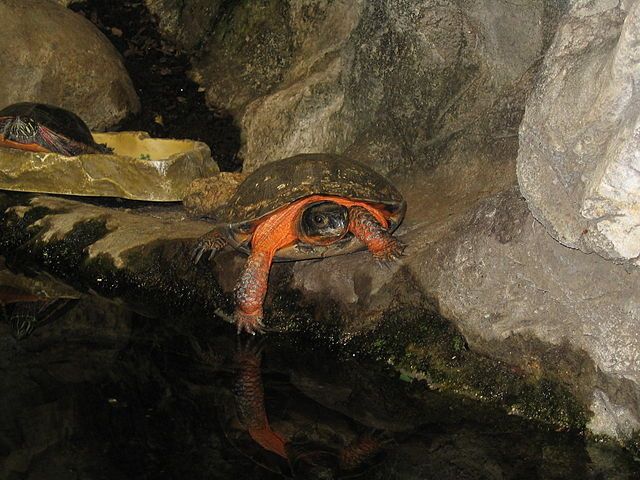
Wood turtles have a peaceful temperament and are omnivorous, feeding on both plants and animals. They are a fascinating species of turtle that need plenty of space to explore. And with their wood-like stripes on their shell, they’ll look like little logs sitting in your backyard pond.
Wood turtles do well when kept in groups and require a tank size of at least 75 gallons with an ambient temperature range of 76 to 86 degrees Fahrenheit. The water in the tank should be maintained at a temperature of at least 75 degrees Fahrenheit, and they need a basking spot heated to 90 degrees Fahrenheit.
African Sideneck Turtle (Pelomedusa subrufa)
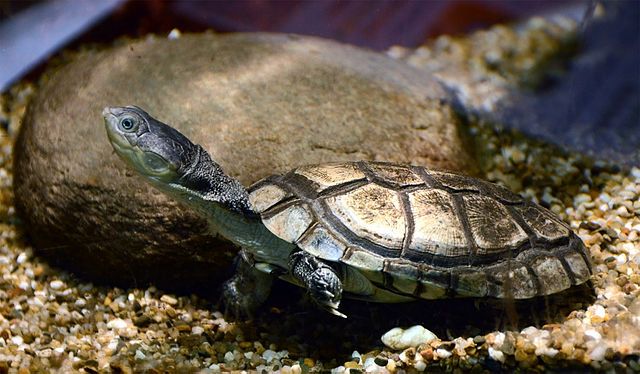
The African Sideneck Turtle is a medium to large-sized aquatic turtle that can be found in slow-moving rivers and streams, as well as lakes and ponds. They are usually a peaceful turtle but will defend themselves if they feel threatened.
The African Sideneck Turtle has an unusual appearance and they are identifiable by their large webbed feet, and inability to retract their head into their shell and they can grow up to be 7-19 inches.
African Sideneck turtles are omnivores and will eat a variety of things, including plants, small fish, insects, crayfish, and other invertebrates. And they should have a varied diet to ensure they get all the nutrients they need.
The recommended tank size for an African sideneck turtle is 40 gallons (150 liters), with a basking spot that reaches 95 degrees Fahrenheit (35 degrees Celsius).
Caspian Pond Turtle (Mauremys caspica)
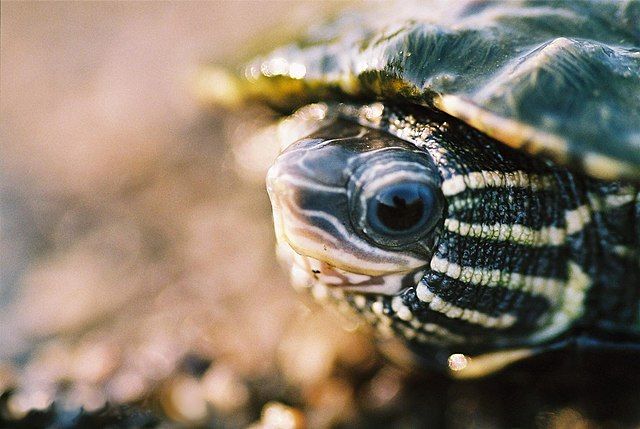
Caspian Pond Turtles are one of the most peaceful aquatic turtles. However, they need a lot of space and require pristine water to thrive in captivity. If you’re looking for an easy-to-breed species that can do well with less care, this might not be your best option.
In order to give them a fighting chance to survive, it is recommended that their tank size should be at least 75 gallons (284 liters). This will provide enough room for them to swim around, and it will help buffer any swings in water quality.
They also need a basking spot where they can bask in temperatures between 90°F – 100°F (32°C – 38°C).
They can live up to 10 years with proper care when kept in clean water with low nitrates. However, if you’re interested in owning one of these turtles make sure you research their needs before purchasing them so they don’t end up sick or worse- dead due to neglect.
Cooter – Northern Red-Bellied Cooter (Pseudemys rubriventris)
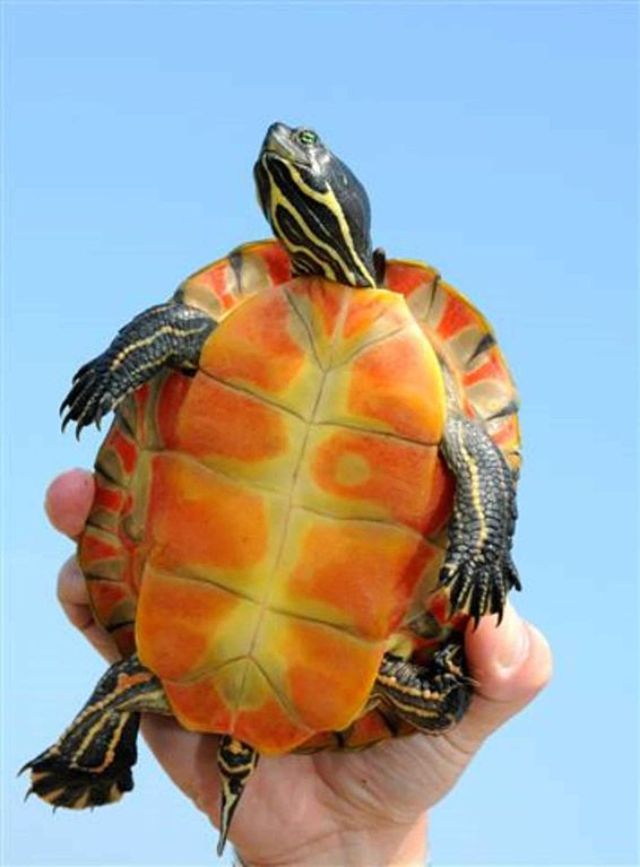
The Northern red-bellied Cooter is a freshwater turtle that can be found in the eastern United States. They have a light green shell with yellow markings on their neck and legs. These turtles are omnivorous and will eat both plants and animals.
They are beginner-level turtles and make great pets for those just starting out with keeping reptiles. These turtles grow to about 10 to 12.5 inches in length, making them one of the larger pet turtles, and they need to be kept in at least a 50 to 75-gallon tank.
Map Turtles
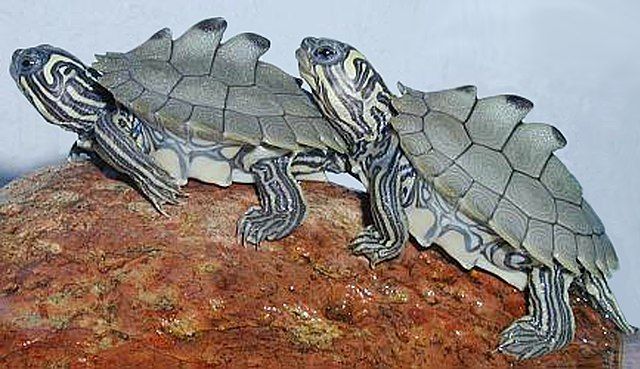
Map turtles are a type of water turtle that can be found in the eastern and central United States. They can be identified by their brown, black, or olive shell with yellow markings on their head and neck. Map turtles can reach a length of 4 to 5 inches for males and 5 to 10 inches for females and have a lifespan of 15-100 years depending on the species.
Map Turtles require a tank size of 25 to 75 gallons (depending on size/age). And their diet consists mostly of aquatic plants and animals but they will also eat insects, fish, low-fat meat, and green leafy vegetables.
Mud Turtles
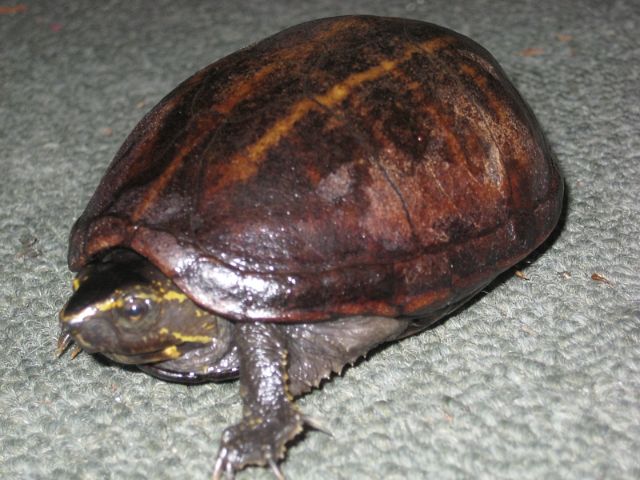
Mud turtles are small, freshwater turtles that can be found in the eastern and central United States. They are easy to care for and make great pets for both beginners and experienced turtle owners.
Mud turtles live 30 to 50 years and can grow 3 to 6 inches long. They need to be kept in at least a 25-gallon aquarium or larger kept at a temperature of 75F to 85F degrees. In addition, they are easy to care for and readily eat aquatic turtle food.
Box Turtles
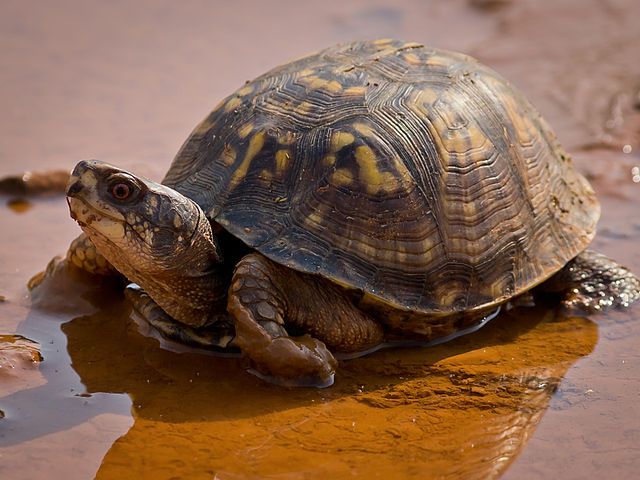
The Box Turtle is a small, hard-shelled reptile that can be found in the eastern and central United States. They are a part of the Emydidae family and have a lifespan of around 40 years, and can grow up to 8 inches long.
Box turtles are omnivores and eat everything from turtle food pellets to insects, as well as green leafy vegetables. And in order to keep a box turtle healthy, it’s important to provide them with a diet that consists of both plant and animal matter.
A tank for a box turtle should be at least 70 gallons, with temperatures averaging 75°F to 85°F. You should also make sure that they have access to UVB lighting, as this helps them metabolize calcium correctly.
Snapper Turtle
Snapper Turtles are large, combative, and powerful turtles that weigh as much as 16 kg. Males are larger than females so males will typically be over 10 kg in weight at the age of maturity. Any specimen above this range is considered exceptional but it can take a long time for them to grow into their full size. The most interesting part about these monsters? Their jaws. These guys have one of the strongest bites out there which evolved from being carnivorous and feeding on crustaceans such as shrimp or crabs.
Spiny Softshell
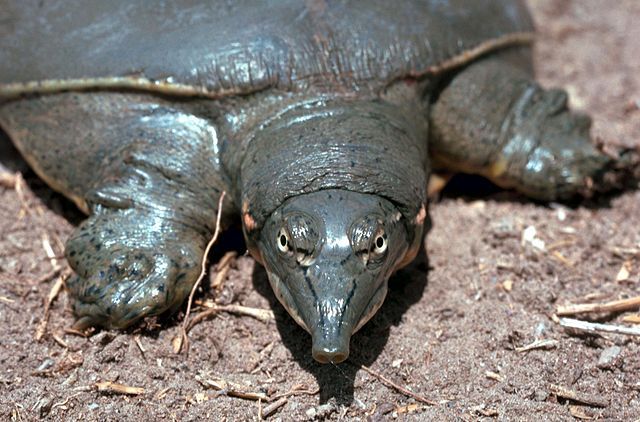
The Spiny Softshell Turtle is a species of semi-aquatic turtle that can be found in the United States and parts of Canada. They are the largest freshwater turtle in North America, with adults ranging in size from 10 inches to 3.3 feet long. Their lifespan is 50 to 100 years, depending on the species. Spiny softshell turtles eat aquatic turtle food, insects, and low-fat meat. They require a tank size of 75 to 600+ gallons (depending on size/gender), with an average temperature of 75°F to 85°F, and a powerful UVB light is necessary for their well-being.
Types of Water Turtles – Types of Aquatic Turtles (Video)
Best Turtle Food for Water Turtles
- Bloodworms
- Turtle food
- Waxworms
- Dandelions
- Duckweed
- Azola
- Feeder Fish (Guppies Minnows)
- Mealworms (Superworms)
- Krill
- Lettuce (Romain)
- Snails
- Shrimp
- Worms (Red Worms & Earthworms)
Aquatic Turtles as Pets
Turtles make great pets for a number of reasons. For one, they are relatively low-maintenance animals that can be left alone for long periods of time without needing attention. They are also interesting creatures to watch and can provide hours of entertainment.
However, before you decide to bring an aquatic turtle into your home, there are some things you should know about their needs and how to care for them properly.
The decision to buy an aquatic turtle is a big one, so you should do your research. When deciding on which breed of turtle, keep in mind what kind of space and pond size you have available for them.
You’ll also need to consider the climate where they will be living because different breeds are better suited to certain environments than others.
Aquatic Turtle Care Requirements
If you’re not sure how much work it takes to care for an aquatic turtle, then make sure you take time to do some research before making any final decisions about whether or not this pet is right for your family.
You need to make sure that the pond or tank you keep them in has enough depth (and surface area) for them as well as providing ample room outside where they can bask under UV light or natural sunlight if possible. The water will also need to be kept clean with good circulation and a powerful filtration system; otherwise, bacteria and toxins will build-up which can lead to infections or death.
Choosing a Water Turtle
When it comes to choosing a water turtle, there are many things to consider. Size is one of the most important factors since you’ll want to select a breed that is small enough to comfortably live in your home aquarium or pond.
Just remember that not all turtles make good pets, and some of the more common breeds can grow quite large. However, with the information on this page and from other resources on the net, choosing the perfect water turtle for you and your family can be easy.
When you’re ready to pick out your new pet, be sure to visit a reputable pet store or breeder so that you can find a healthy and sustainably sourced turtle.
The Four Inch Rule
The Four Inch Rule was implemented by the Food and Drug Administration in 1974 as a way to keep children safe from salmonella. At the time, it was believed that children would put anything small into their mouths, so all turtles with a carapace under four inches were prohibited from being sold.

